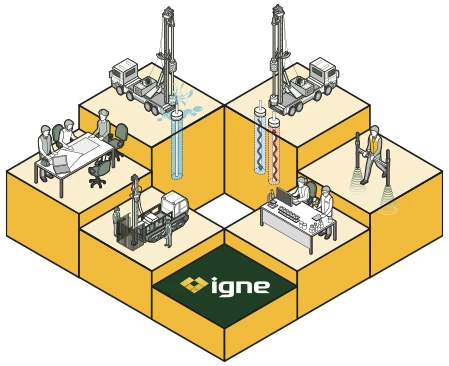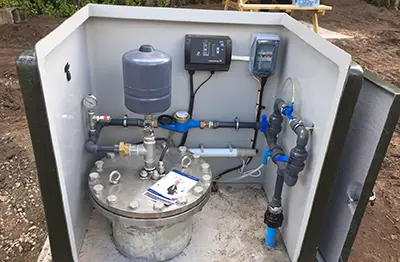

Dual Focused Resistivity Logging
Dual focused resistivity logging is a geophysical technique used to measure the electrical resistance of subsurface materials surrounding a borehole
About
Analysing Resistivity
By analysing resistivity values, we can infer formation properties, identify aquifer zones, and evaluate the likely yield and quality of water-bearing layers.
At Igne, we use dual focused resistivity tools to support high-value decision-making in water borehole development, geothermal design, and ground investigation. This method is particularly useful where cores are limited or where further formation characterisation is needed in uncased or open-hole conditions.

The measurements
What Does Dual Focused Resistivity Measure?
This log records the electrical resistivity of the formation adjacent to the borehole. It’s called “dual focused” because it measures at two depths of investigation - typically shallow and deeper zones - helping to distinguish between borehole fluid and formation responses.
Resistivity is influenced by:
- Grain size and porosity
- Saturation levels (wet vs dry zones)
- Salinity and mineral content of groundwater
- Clay content and lithology
High resistivity values may indicate clean, dry sands or competent rock, while low resistivity could signal clays, shale, or saline/brackish water.
The uses
Applications of Resistivity Logging
Dual focused resistivity is used across sectors to:
- Characterise aquifers and assess water yield potential
- Identify saline intrusion or water quality changes
- Refine geological models
- Support screen placement and borehole design
- Complement gamma, caliper or flow logs for multi-parameter analysis
- Provide baseline data for contaminated land and remediation projects
Because it looks beyond the borehole wall, resistivity is especially valuable in evaluating formation conditions that can't be seen directly.
The Process
How Resistivity Logging Works
A dual focused resistivity probe is lowered into an open or uncased borehole. The tool emits a small electrical current into the formation via electrodes. By measuring how easily this current flows through the surrounding material, the tool calculates resistivity at two different depths, helping to isolate the true formation response from borehole fluid effects.
The resulting log presents resistivity versus depth, giving a clear picture of lithological variation and hydrogeological potential.
FAQ
Frequently Asked Questions about Dual Focused Resistivity Logging
- Can resistivity logging identify fresh water versus saline water zones?
Yes. Lower resistivity values often indicate saline or mineralised water, while higher values suggest fresher, cleaner water, particularly in porous formations like sand or gravel.
- Do I need to remove casing before running resistivity logs?
Yes; resistivity logging requires direct contact with the formation, so it must be done in open-hole or uncased sections of the borehole.
- Can this log distinguish between clay and shale?
It can indicate low-resistivity zones, which often correspond to clays or shales. When combined with gamma logs, it becomes easier to differentiate between different fine-grained materials.
- What depth range is possible?
We can log to several hundred metres, depending on borehole conditions and access. Both shallow and deeper responses are recorded in a single run.
- How does resistivity logging support borehole design?
It helps identify where aquifers are, how saturated they are, and where screens or intakes should be placed. This leads to more efficient and better-targeted installations.
- Is resistivity logging invasive or damaging?
No; it’s a non-destructive, low-voltage technique that doesn’t affect the formation or water quality in any way.
The Next Step
See Beyond the Borehole Wall with Dual Focused Resistivity
When you need to understand the true behaviour and properties of the ground around your borehole, resistivity logging delivers valuable insights to guide your next move.
Give us a call today to arrange a formation evaluation survey and take the guesswork out of borehole design and development.


Temperature & Conductivity Logging

Flowmeter Logging

Caliper Measurement Logging

Dual Focused Resistivity Logging

